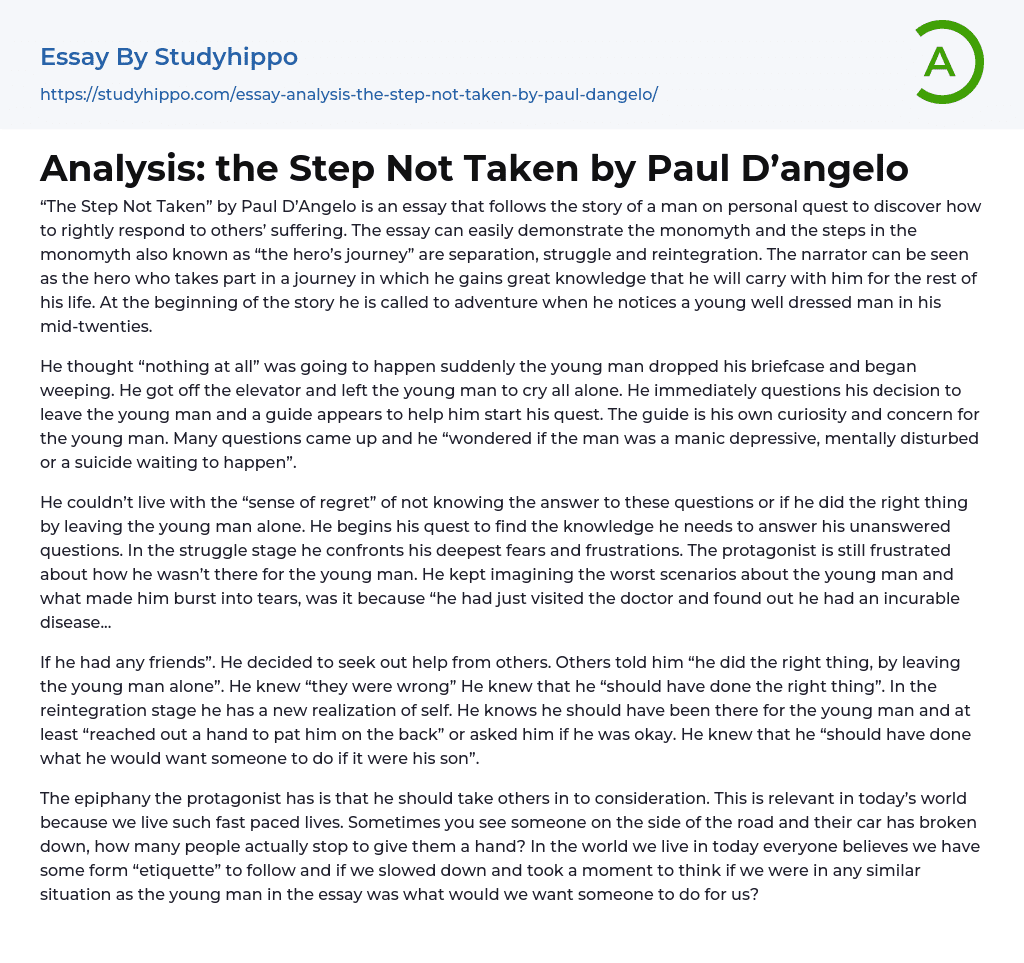

Analysis: the Step Not Taken by Paul D’angelo Essay Example
“The Step Not Taken” by Paul D’Angelo is an essay that follows the story of a man on personal quest to discover how to rightly respond to others’ suffering. The essay can easily demonstrate the monomyth and the steps in the monomyth also known as “the hero’s journey” are separation, struggle and reintegration. The narrator can be seen as the hero who takes part in a journey in which he gains great knowledge that he will carry with him for the rest of his life. At the beginning of the story he is called to adventure when he notices a young well dressed man in his mid-twenties.
He thought “nothing at all” was going to happen suddenly the young man dropped his briefcase and began weeping. He got off the elevator and left the young man to cry all alon
...e. He immediately questions his decision to leave the young man and a guide appears to help him start his quest. The guide is his own curiosity and concern for the young man. Many questions came up and he “wondered if the man was a manic depressive, mentally disturbed or a suicide waiting to happen”.
He couldn’t live with the “sense of regret” of not knowing the answer to these questions or if he did the right thing by leaving the young man alone. He begins his quest to find the knowledge he needs to answer his unanswered questions. In the struggle stage he confronts his deepest fears and frustrations. The protagonist is still frustrated about how he wasn’t there for the young man. He kept imagining the worst scenarios about the young man and what made him
burst into tears, was it because “he had just visited the doctor and found out he had an incurable disease...
If he had any friends”. He decided to seek out help from others. Others told him “he did the right thing, by leaving the young man alone”. He knew “they were wrong” He knew that he “should have done the right thing”. In the reintegration stage he has a new realization of self. He knows he should have been there for the young man and at least “reached out a hand to pat him on the back” or asked him if he was okay. He knew that he “should have done what he would want someone to do if it were his son”.
The epiphany the protagonist has is that he should take others in to consideration. This is relevant in today’s world because we live such fast paced lives. Sometimes you see someone on the side of the road and their car has broken down, how many people actually stop to give them a hand? In the world we live in today everyone believes we have some form “etiquette” to follow and if we slowed down and took a moment to think if we were in any similar situation as the young man in the essay was what would we want someone to do for us?
- Leader essays
- Biography essays
- Power essays
- Superhero essays
- Mission essays
- Purpose essays
- Helping Others essays
- Actions essays
- Business Law essays
- Contract essays
- Consumer Protection essays
- Property essays
- Ownership essays
- Agreement essays
- Common Law essays
- Contract Law essays
- Justice essays
- Security essays
- Tort Law essays
- United States Constitution essays
- Crime essays
- Lawsuit essays
- Treaty essays
- Family Law essays
- Marijuana Legalization essays
- Constitution essays
- War on Drugs essays
- Court essays
- Jury essays
- Police essays
- Protection essays
- Community Policing essays
- Criminal Law essays
- Judge essays
- Lawyer essays
- Employment Law essays
- Copyright Infringement essays
- Injustice essays
- Intellectual Property essays
- Breach Of Contract essays
- Jurisprudence essays
- Social Injustice essays
- Juvenile Justice essays
- Internet Privacy essays
- Cyber Security essays
- Bill Of Rights essays
- Civil Liberties essays
- First Amendment To The United States Constitution essays
- Fourth Amendment To The United States Constitution essays
- Second amendment essays



